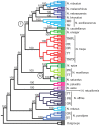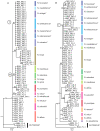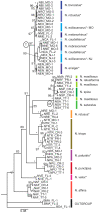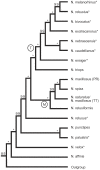Molecular phylogenetics of the genus Neoconocephalus (orthoptera, tettigoniidae) and the evolution of temperate life histories
- PMID: 19779617
- PMCID: PMC2745656
- DOI: 10.1371/journal.pone.0007203
Molecular phylogenetics of the genus Neoconocephalus (orthoptera, tettigoniidae) and the evolution of temperate life histories
Abstract
Background: The katydid genus Neoconocephalus (25+ species) has a prominent acoustic communication system and occurs in large parts of the Neotropics and Nearctic. This group has been subject of numerous behavioral, physiological, and evolutionary studies of its acoustic communication system. Two distinct life histories occur in this group: The tropical life history incorporates multiple generations/year and direct egg development without environmental triggers. Temperate life history is characterized by overwintering in the egg stage, cold trigger of egg development, and one generation/year. This study reconstructs the phylogenetic relationships within the genus to (1) determine the evolutionary history of the temperate life history, and (2) to support comparative studies of evolutionary and physiological problems in this genus.
Methodology/principal findings: We used Amplified Fragment Length Polymorphisms (AFLP), and sequences of two nuclear loci and one mitochondrial locus to reconstruct phylogenetic relationships. The analysis included 17 ingroup and two outgroup species. AFLP and mitochondrial data provided resolution at the species level while the two nuclear loci revealed only deeper nodes. The data sets were combined in a super-matrix to estimate a total evidence tree. Seven of the temperate species form a monophyletic group; however, three more temperate species were placed as siblings of tropical species.
Conclusions/significance: Our analyses support the reliability of the current taxonomic treatment of the Neoconocephalus fauna of Caribbean, Central, and North America. Ancestral state reconstruction of life history traits was not conclusive, however at least four transitions between life histories occurred among our sample of species. The proposed phylogeny will strengthen conclusions from comparative work in this group.
Conflict of interest statement
Figures





Similar articles
-
Evolutionary diversification of the auditory organ sensilla in Neoconocephalus katydids (Orthoptera: Tettigoniidae) correlates with acoustic signal diversification over phylogenetic relatedness and life history.J Evol Biol. 2017 Jun;30(6):1094-1109. doi: 10.1111/jeb.13066. Epub 2017 May 2. J Evol Biol. 2017. PMID: 28295793
-
Evolution of novel signal traits in the absence of female preferences in Neoconocephalus katydids (Orthoptera, Tettigoniidae).PLoS One. 2010 Aug 27;5(8):e12457. doi: 10.1371/journal.pone.0012457. PLoS One. 2010. PMID: 20805980 Free PMC article.
-
Phylogeny and acoustic signal evolution of a pure tone song katydid Pseudophyllus titan (Orthoptera: Tettigoniidae) based on the complete mitogenome.Mitochondrial DNA A DNA Mapp Seq Anal. 2019 Apr;30(3):385-396. doi: 10.1080/24701394.2018.1502280. Epub 2018 Oct 5. Mitochondrial DNA A DNA Mapp Seq Anal. 2019. PMID: 30289002
-
A century of paraphyly: a molecular phylogeny of katydids (Orthoptera: Tettigoniidae) supports multiple origins of leaf-like wings.Mol Phylogenet Evol. 2013 Dec;69(3):1120-34. doi: 10.1016/j.ympev.2013.07.014. Epub 2013 Jul 24. Mol Phylogenet Evol. 2013. PMID: 23891949
-
Innate releasing mechanisms and fixed action patterns: basic ethological concepts as drivers for neuroethological studies on acoustic communication in Orthoptera.J Comp Physiol A Neuroethol Sens Neural Behav Physiol. 2019 Feb;205(1):33-50. doi: 10.1007/s00359-018-01311-3. Epub 2019 Jan 7. J Comp Physiol A Neuroethol Sens Neural Behav Physiol. 2019. PMID: 30617601 Free PMC article. Review.
Cited by
-
Character State Reconstruction of Call Diversity in the Neoconocephalus Katydids Reveals High Levels of Convergence.PLoS Curr. 2016 Mar 11;8:ecurrents.tol.0c5d76728d73ef9c3dbe8065f70ea4cb. doi: 10.1371/currents.tol.0c5d76728d73ef9c3dbe8065f70ea4cb. PLoS Curr. 2016. PMID: 27110432 Free PMC article.
-
Testing alternative hypotheses on the origin and speciation of Hawaiian katydids.BMC Ecol Evol. 2022 Jun 22;22(1):83. doi: 10.1186/s12862-022-02037-2. BMC Ecol Evol. 2022. PMID: 35733091 Free PMC article.
-
Climate and soil type together explain the distribution of microendemic species in a biodiversity hotspot.PLoS One. 2013 Dec 18;8(12):e80811. doi: 10.1371/journal.pone.0080811. eCollection 2013. PLoS One. 2013. PMID: 24367480 Free PMC article.
-
Calling song signals and temporal preference functions in the cricket Teleogryllus leo.J Comp Physiol A Neuroethol Sens Neural Behav Physiol. 2012 Nov;198(11):817-25. doi: 10.1007/s00359-012-0751-0. Epub 2012 Sep 4. J Comp Physiol A Neuroethol Sens Neural Behav Physiol. 2012. PMID: 22945775
-
The genetic differentiation of a cricket (Velarifictorus micado) with two modes of life cycle in East Asia after the middle Pleistocene and the invasion origin of the United States of America.Ecol Evol. 2020 Nov 9;10(24):13767-13786. doi: 10.1002/ece3.6967. eCollection 2020 Dec. Ecol Evol. 2020. PMID: 33391679 Free PMC article.
References
-
- Alexander RD. A comparative study of sound production in insects with special reference to the singing Orthoptera and Cicadidae of the Eastern United States. 1956. PhD thesis, Ohio State University.
-
- Meixner AJ, Shaw KC. Acoustic and associated behavior of the coneheaded katydid, Neoconcocephalus nebrascensis Orthoptera: Tettigoniidae. Ann Entomol Soc Am. 1986;79:554–565.
-
- Greenfield MD. Unsynchronized chorusing in the coneheaded katydid Neoconocephalus affinis (Beauvois). Anim Behav. 1983;31:102–112.
-
- Brush JS, Gian VG, Greenfield MD. Phonotaxis and aggression in the coneheaded katydid Neoconocephalus affinis. Physiol Entomol. 1985;10:23–32.
-
- Meixner AJ, Shaw KC. Spacing and movement of singing Noeconocephalus nebrascensis males (Orthoptera: Copiphorinae). Ann Entomol Soc Am. 1979;72:602–606.
Publication types
MeSH terms
LinkOut - more resources
Full Text Sources

